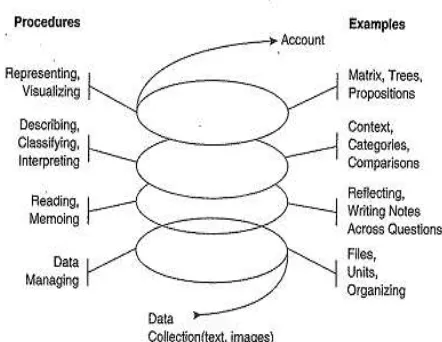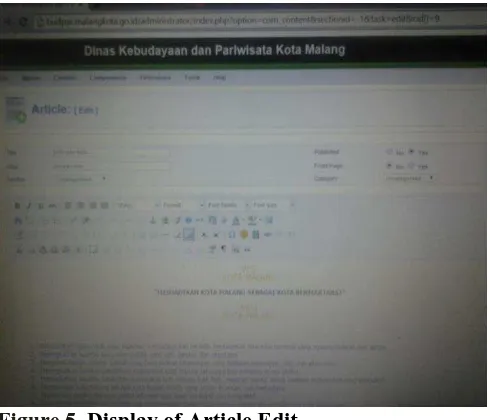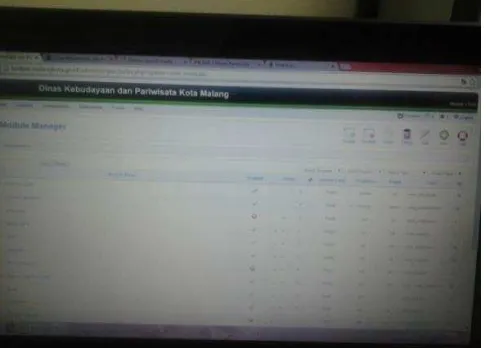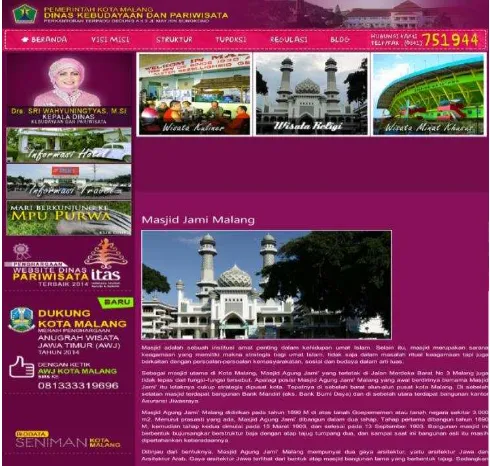Jurnal Administrasi Bisnis (JAB)|Vol. 26 No. 1 September 2015| administrasibisnis.studentjournal.ub.ac.id
1
ANALYSIS OF WEB BASED TOURISM INFORMATION SYSTEMS
UTILIZATION
(Case Study at Integrated Office Department of Culture and Tourism City of Malang)
Decca Putri Rahajeng Kertahadi
Riyadi
Faculty Of Administrative Science, Brawijaya University e-mail:[email protected]
Abstract
The purpose of this study is to analyze and determine weaknesses and strengths of the use of web-based tourism information systems at the Department of Culture and Tourism of the city of Malang.
This research was conducted by using descriptive method with qualitative research approach. The data collection was done by using interviews, observation and documentation. Data analysis was performed using data analysis spiral in accordance with the stages. The results showed that the use of web-based tourism information system which has been implemented by the Department of Culture and Tourism of the city of Malang is very effective in helping the agency to promote tourism in the city of Malang to the general public, domestic and foreign tourists. With the use of web-based tourism information system, tourists or visitors to the website can access the website of Culture and Tourism Malang for 24 hours anywhere and anytime.
Keywords: information systems utilization, tourism information systems, web based tourism.
INTRODUCTION
Information technology today has grown very rapidly and brought very big change for people living in today's era modern, because to the technology of information can be obtained quickly, accurately, and it’s not limited by time and place. One of the growing sectors in technology development is the field of tourism which contributes to distribute tourist information objects that are more interactive, especially through the internet technology.
Indonesia is a country that has a wide variety of tourist attractions, such as the nature, artificial tourism, and cultural tourism. Each of the tour has its own characteristics and beauty. The tourism sector is an important factor for regional and state revenues, because besides providing benefits for the tour itself, it also gives the advantage for the supporting infrastructure, such as restaurants, lodging places, travel agencies, souvenir sellers and craft stores.
Along with the progress and development of rapid information technology today has changed the mindset of the people, that is the mindset that requires fast-paced and up to date information. As is the case with information about tourist attractions in the city of Malang, people need
advanced information media, more dynamic and interactive. Tourism information system is indispensable as a means of delivering information to the people who want to know the tourist areas of interesting to be visited.
Means information using internet technology to be one the form of the development of information technology today. To achieve these objectives the necessary information about tourist destinations, exciting attractions, such as the transportation facilities which is available to reach the destination, the tourism products of interest and so forth. To obtain those such information, travelers often have trouble because they do not know where and who to ask for information. In short, need of information needs in field of tourism is getting increased and need to be prepared with a neat and structured so that it can be easily accessed.
Jurnal Administrasi Bisnis (JAB)|Vol. 26 No. 1 September 2015| administrasibisnis.studentjournal.ub.ac.id
2 tourist attractions in the city of Malang wider and
can be accessed easily.
Based on the background described above, the formulation of the problem can be explained as follows:
1. How does the description of the utilization of web-based tourism information system which has been implemented in the Department culture and tourism Malang? 2. What are the strength and the weaknesses
related to the utilization of Web-based tourism information systems which have been implemented by the Department of Culture and Tourism of the city of Malang?
LITERATURE REVIEW
Definition of Information Systems
The basic theory in this research is using by Laudon (2012:15) as follow:
“An information system can be defined technically as a set of interrelated components that collect (or retrieve), process, store, and distribute information to support decision making and control in an organization. In addition to supporting decision making, coordination, and control, information systems may also help managers and workers analyze problems, visualize complex subjects, and create new products”.
Web-Based Information Systems
According to Laudon website is the most popular internet services. The website is a system with standards universally accepted to store, retrieve, organize, and display information in a network environment information is stored and displayed as an electronic pages can contain text, graphics, animation, sound and video (Laudon&Laudon , 2006: 22).
Based on the description, researcher conclude that a web-based information system consists of one or more web applications that each component has a specific function. Wherein each of the components supporting each other in order to achieve a web-based information systems in general. The authors conclude that the system is a web-based information systems based on application or system information using web technology, namely the Internet to a web browser can be accessed anywhere and convey information to the user.
Information Systems for The Public Sector One of the government's efforts to achieve good governance is to implement the electronic
government systems. E-government is the use of information technology by the government to provide information and services to the community, business affairs, as well as matters relating to the government. E-government is applied to improve the internal efficiency of the public services.
According Sutabri (2012: 157) : "in order to run the e-government system needs a good and regular information from each of the institutions of government in which each government agency must have information systems that include standard minimum requirement for factors of the information system human, technological, and organizational procedures, so that all that could be obtained from an information system that is well established. Because such information systems will facilitate the government in carrying out its functions to the community ".
Definition of The Tourism
Definition of tourism according to Fannel (1999:4) in I GdePitana and I Ketut Surya Diarta (2009:45) as follows:
“Tourism is defined as the interrelated system that includes tourist and the associated services that are provided and utilized (facilities, attraction, transportation, and accommodation) to aid in their movement”.
Some of the basic components that are generally agreed within the limits of tourism (especially international tourism), as follows:
a. Traveler, that is, those who travel between two or more localities.
b. Visitor, that is, those who travel to the area which is not a residence, less than 12 months, and the purpose of his journey is not to engage in activities to earn a living, or the livelihood at the destination.
c. Tourist, which is part of the visitors who spent at least one night (24 hours) in the areas visited (WTO, 1995).
Tourism Information Systems
Tourism information systems are travel-related information provided to tourists or potential tourists. Information can include traffic conditions, availability of tourist rides, public transportation conditions and others. Traveler information systems using information technology related to the travel process and disseminate information useful to travelers.
Jurnal Administrasi Bisnis (JAB)|Vol. 26 No. 1 September 2015| administrasibisnis.studentjournal.ub.ac.id
3 “Tourism is defined as the interrelated
system that includes tourist and the associated services that are provided and utilized (facilities, attraction, transportation, and accommodation) to aid in their movement”.
From the definition above, can explained that Information systems have to really understand the needs of the data users, because it has the characteristics of tourism information data such diverse objects and attractions, hotel data, the data infrastructure and transportation, statistical data such as the number of tourists and tour guides are needed managed in an integrated way.
Research Methods
Research that is used describes the relationship between the phenomena under study with a systematic, factual and accurate. Thus the study did not use a hypothesis test. However, only using the data in the form of words or pictures and collect data by interview.
According to Nazir (2003: 24) is a descriptive study "method in researching the status of human groups, an object, a condition, a system of thought, or a class of events in the present". This study aims to resolve a case of use of Web-based tourism information systems, therefore this research is a case study. Through this case study analysis of the intensity in the use of web-based information systems can be carried out in depth, in terms of the period of time to express an idea, the strengths and weaknesses of the use of Web-based tourism information systems which have been implemented by the Department of Culture and Tourism of Malang city.
Data Collection Techniques
Important step in the research is a collection of data, where the data collection techniques will affect the quality of data obtained. The data collection techniques used were as follows:
1. Interview
This is a way in which to get the data or information required to conduct interviews directly to parties who can provide the necessary information. In this activity, the interviews conducted on the Subdevision Programming in the Department Culture and Tourism of Malang city. Interview by the Subdevisions Programming conducted to know the description of the utilization of web-based tourism information system and the weaknesses and strengths of the web-based tourism information system.
2. Observation
It is the means used by researchers to observe the implementation of the use of Web-based tourism information systems by the Department of Culture and Tourism of the city of Malang. In observation of researchers directly involved in the situation under study.
3. Documentation
A method of data collection is done by studying documents, reports and records to the Department of Culture and Tourism of Malang City related to the data needed to be further investigated.
A method of data collection is done by studying documents, reports and records to the Department of Culture and Tourism of Malang City related to the data needed to be further investigated.
Data Analysis
a. Validity of Data
This analysis is used to determine the results of the research with qualitative methods by Creswell and Miller (2000). Strategy in determining the validity of qualitative research data is Data reduction, Display data, Conclusions and Verification.
b. Data Analysis Spiral
Analysis data on research using data analysis spiral that has been used by Creswell (2007).
Figure 1. The Data Analysis Spiral
(Source: Qualitative Inquiry & Research Design (2007:150))
Focus and Data Reduction
Jurnal Administrasi Bisnis (JAB)|Vol. 26 No. 1 September 2015| administrasibisnis.studentjournal.ub.ac.id
4 tourism information system at the Department of
Culture and Tourism of the city of Malang by sections programming staff,about:
1. Website of The Department of Culture and Tourism of Malang
Websites in the Department of Culture and Tourism Malang using Joomla is a content management application system which has the function menu, including:
a) Admin page
Admin page is the main page of the website that is only accessible by those in charge of managing tourism website and serves to regulate members on the website. This page is used to manage matters relating to tourism website Malang.
Figure 2. Display of Admin login page
(Source : Website of the Department of Culture and Tourism)
b) Site Menu
Site menu on the website consists of:
a) Control Panel: serves to ferment activity Joomla CMS;
b) User Manager: serves to regulate members on the website of Culture and Tourism of Malang;
c) Media Manager: work to the general configuration.
c) Menus Menu
Menus menu is a page that consists of:
a) Menu Manager: which serves to create and edit menus tourism information;
b) Menu Trash: serves to remove the menu. d) Content Menu
Menu Content is a process to manage the content on the website page Malang tourism.
Figure 3. Display of Content Menu
(Source : Website of the Department of Culture and Tourism)
Figure 4. Display of Articel Manager
(Source : Website of the Department of Culture and Tourism)
Figure 5. Display of Article Edit
Jurnal Administrasi Bisnis (JAB)|Vol. 26 No. 1 September 2015| administrasibisnis.studentjournal.ub.ac.id
5 e) Component Menu
Component menu on the website of Culture and Tourism of the city of Malang, consisting of:
a) Contact: serves to set the institutions contact information on the website;
b) News Feeds: To display the content in the form of feed on other websites. Administrator classify each news feeds into the appropriate category. At each feed can set the number of articles to be displayed; c) Web Links: functions to manage links to
other websites. f) Extentions
Extension is an additional application that can be added to the website. Website of Culture and Tourism Malang using some applications that are displayed on the main page of the website.
Figure 6. Display of Module Manager
(Source : Website of the Department of Culture and Tourism)
g) Tools
Tool on the website of Culture and Tourism Malang consists of:
a) Read Message: Function to get into the private message page, this page is intended to read the message to each member of the website;
b) Write Message: Function to send a message on another web;
c) Mass Email: Function to send mass messages to members of the web;
d) Global Check-in: Serves to view the article that is locked. It is caused when a user is editing a finished article but not to edit them and cause other users cannot edit;
e) Cache: Function to clear the cache on a web server and can accelerate the performance of joomla website.
h) Website Page
View website web page is at the Department of Culture and Tourism Malang to provide tourism information. This can be seen in the image below:
Figure 7. Disp;ay of Website page Department of Culture and Tourism of Malang City
(Source : Website of the Department of Culture and Tourism)
Data Analysis and Interpretation
1. Analysis of the utilization of web-based tourism information system
From interviews and analysis that has been carried out by researchers, it can be seen that the utilization of web-based information systems at the Department of Culture and Tourism Malang very important for institutions in providing information to the tourists or visitors. Because of the internet, the Department of Culture and Tourism Malang can share information about the sights in the city of Malang, whether it be a culinary tours, religious tours, special interest tours, hotel information, transportation information, and information about the artist biography in town Malang.
2. Analysis on the website of Department of Culture and Tourism of Malang
Results of the research in the Department of Culture and Tourism of the city of Malang, the following is the view of the outside website page of Culture and Tourism Malang which can be directly accessed by visitors or tourists.
Homepage
Jurnal Administrasi Bisnis (JAB)|Vol. 26 No. 1 September 2015| administrasibisnis.studentjournal.ub.ac.id
6 Figure 8. Display of Home page
(Source : Website of the Department of Culture and Tourism)
Figure 9. Display of Home page
(Source : Website of the Department of Culture and Tourism)
From the above that the Department of Culture and Tourism Malang has the objective is not only to provide information only tourism, but also introduced the objectives of the organization and also the main tasks so that users can know more clearly about the organization Department of Culture and Tourism Malang.
Page Content
Pages content of the Department Culture and Tourism of Malang city, there are some parts of the submenu that consists of :
a) Culinary Tourism
Page content Culinary Tourism is one of the important pages of web visitors who want to know about culinary travel information in Malang. In this culinary tour page also described the location and address of some culinary place in the city of Malang, making it easier for tourists who want to visit a culinary tour in Malang.
Figure 10. Page of Content a display of Culinary Tourism
(Source : Website of the Department of Culture and Tourism)
b) Religious Tourism
Page content Religious Tourism is a page that displays information several places of worship were also made history in Malang.
Figure 11. Display of Religious Tourism
(Source : Website of the Department of Culture and Tourism)
c) Special Interest Tourism
Jurnal Administrasi Bisnis (JAB)|Vol. 26 No. 1 September 2015| administrasibisnis.studentjournal.ub.ac.id
7 Figure 12. A Display of Special Interest Tourism
(Source : Website of the Department of Culture and Tourism)
d) Hotel Information
Hotel Information content page is a page that displays information about the hotel in the city of Malang. As a tourist destination, Department of Culture and Tourism Malang has displays information about the hotel information and the details and address in order to make it easier for the user location or tourists to access the site.
Figure 13. Page of Content Display Information Another Hotel
(Source : Website of the Department of Culture and Tourism)
e) Transportation Line
Domestic and foreign tourists who want to visit in the city of Malang but not driving can see information about the city transit lines on the website Department of Culture and Tourism Malang.
Figure 14. Display Page Content Information Transportation Line
(Source : Website of the Department of Culture and Tourism)
3. The Strength of Web-based Tourism information systems in the Department of Culture and Tourism Malang
Based on conducted that the strenght of the use of the website or the Internet at the Department of Culture and Tourism Malang, among others:
a) Extending the reach of the promotion By utilizing the website products or services in the citizens to inform more widely known even to foreign countries. With the breadth of tourism promotion Malang, it will automatically boost the economy and improve people's lives Malang.
b) Operational cost savings
By utilizing the website operational costs can be more efficient. The cost to create, process, distribute, store, and restore information can also be reduced spending by agencies. It can reduce the use of paper in a variety of activities for promoting attractions such as offline advertising costs in the form of newspapers, magazines, banners etc.
Jurnal Administrasi Bisnis (JAB)|Vol. 26 No. 1 September 2015| administrasibisnis.studentjournal.ub.ac.id
8 The Internet is a network that is cheaper to
send a fax or e-mail via the internet instead of doing direct dial telephone.
4. The Weaknesses of Web-based Tourism Information Systems in the Department of Culture and Tourism Malang
Based on conducted that the weaknesses of the use of the website or the Internet at the Department of Culture and Tourism Malang, among others: a) Website user reporting
Reporting users or visitors to weekly, monthly, or yearly on the website is not updated, so as to be able to see updates previous data reporting is quite difficult. And also cannot see the comparison of the number of visitors to weekly, monthly, or per year.
b) There is no column for the service comments or questions for web visitors who want to leave a comment or question for the agencies involved. c) No Tourist Map Malang on the website. Malang Tourist Map important to facilitate the tourists who want to travel to the city of Malang.
Proposition
In the data analysis model with John Creswell (2007: 151) in chapter 3, explained that there are four steps of data analysis including data management, reading and memoing, explain, and also the data are presented. Step one to three steps have been made in this chapter where the following procedures and explanations of the information system implementation is done. In the final step of the study or in the fourth step will result in the proposition.
When the website of the Department of Culture and Tourism of Malang city is being implemented, it will:
1) Help the institutions to promote tourism in the city of Malang to the public, domestic and foreign tourists. And for the people and tourists, they do not need to come directly to the Department of Culture and Tourism of Malang city to search for travel information Malang. 2) Easy to use and open source in providing tourist
information to the public makes the process of user information to be more effective, especially tourism information online to expand the range of tourism information, and also features can be used freely.
3) The website is easy to used by the institutions because although not understand the programming language, website managers can still utilize of the websites.
4) The website of the Department of Culture and Tourism of Malang city is very interesting to visited and ease the society or tourists in search of tourist information in accordance with its kind.
Web-Based Tourism Information System as an objective in providing information tourist destinations, interesting attractions, transportation within reach tourist destinations, tourism product to tourist in the city of Malang.
Conclusions and Recommendation Conclusions
1) The Department of Culture and Tourism Malang has implemented utilization of web-based tourism information system that aims for tourism promotion media city of Malang, news and provide information to tourists or visitors on tours of the city of Malang in the form of culinary tourism, shopping tourism, religious tourism, hotel information, information transport etc. Department of Culture and Tourism of the city of Malang to search for such information. 3) Website optimization is done by completing the
means language and information, as well as increase the level of interaction in communicating with visitors or tourists by using other social networking alternatives.
Suggestions
1) Development and maintenance of web-based tourism information systems is very important for tourism information systems which have been implemented by The Department of Culture and Tourism of city of Malang, in order to better and more complete tourist information system that can be used according to the needs of tourists or visitors.
Jurnal Administrasi Bisnis (JAB)|Vol. 26 No. 1 September 2015| administrasibisnis.studentjournal.ub.ac.id
9 external factors of web-based tourism
information systems.
3) In addition to utilizing the website as tourism information, should be The Department of Culture and Tourism city of Malang also can utilizing free social networking such as Facebook, Twitter, etc., to improve the information and interaction in communicating with visitors or tourists.
4) Administrators need to perform their chart updates regarding Utilization Information System Web-Based Tourism in any month or year to better determine the development of utilization of of web-based information system in any month or year.
REFERENCE
Creswell, John W. 2007. Qualitative Inquiry and Research Desaign: Choosing Among Five
Approaches. Second Edition.SAGE
Publications.
Ismayanti. 2010. Pengantar Pariwisata. Jakarta: PT.Gramedia widiasarana Indonesia.
Kusmayadi and Sugiarto, Endar. 2000. Metode Penelitian Dalam Bidang Kepariwisataan. Jakarta. Penerbit: PT. Gramedia Pustaka Utama.
Laudon, Kenneth C., Jane P. Laudon. 2005. Sistem
Informasi Manajemen Mengelolah
Perusahaan Digital. Edisi 8 Bahasa
Indonesia. Yogyakarta. Penerbit: ANDI
McLeod, Jr. Raymond. 2001. Management
Information System. Prentice Hall
International Inc.
O’Brien, A James. 2008. Pengantar Sistem
Informasi: Perspektif Bisnis dan Manajemen. Edisi 12. Selemba Empat.
Pitana, I Gde and Diarta, I Ketut Surya. 2009. Pengantar Ilmu Pariwisata. Yogyakarta. Penerbit: ANDI.
Pendit, S Nyoman. 1990. Ilmu Pariwisata. Cetakan Keempat. Jakarta. Penerbit: PT. PRADNYA PARAMITA.
Sammeng, Andi Mapping. 2001. Cakrawala Pariwisata. Balai Pustaka: Jakarta.
Sutabri, Tata. 2012. Konsep Sistem Informasi. Yogyakarta: Penerbit ANDI.
Turban. E, Aronson Jay. E, PengLian. 2005. Decision Support Systems and Intelligent Systems. Seven Edition. Penerbit: ANDI.
Yoeti, A.O. 1996. Pemasaran Pariwisata. Bandung. Aksara.
Undang-Undang RI No.10.2009. “UU Kepariwisataan No. 10 Tahun 2009”.
Instruksi Presiden RI No. 3 Tahun 2003 Tentang Kebijakan dan Strategi Nasional Pengembangan E-Goverment, accessed on
June 14, 2014 from
http://ppidkemkominfo.files.wordpress.com/2 012/12/instruksi_presiden_no_3_th_20031.pdf




